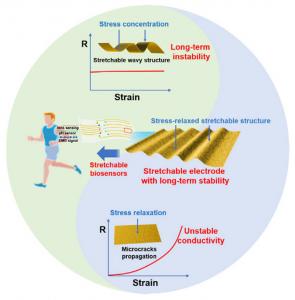Smart biosensors that bend, stretch, and sense
GA, UNITED STATES, August 27, 2025 /EINPresswire.com/ -- A new generation of biosensors is transforming how we monitor health—by stretching with the body and sensing multiple signals in real time. Scientists have developed highly flexible biosensors that detect sweat pH, electrolyte levels, and electromyography (EMG) signals simultaneously. Their secret lies in a hybrid microstructure (HMS) that combines wave-like flexibility with microcrack stress dispersion, ensuring both durability and precision. Even under 60% strain or after 5000 stretching cycles, the sensors retain electrical stability. Coated with conductive polymers, the devices provide continuous and accurate feedback, making them ideal for next-level wearable technologies in personalized health monitoring.
Wearable biosensors are ushering in a new era of real-time, non-invasive health monitoring by detecting biochemical markers in sweat, saliva, or interstitial fluid. These signals can reveal hydration status, muscle activity, and early signs of disease. However, most existing devices either lack the flexibility to conform to human movement or can only measure one biomarker at a time. The complex, dynamic nature of human physiology calls for biosensors that are both multifunctional and mechanically robust. Due to these challenges, there is a growing need for stretchable, skin-friendly systems capable of accurately monitoring multiple physiological indicators under real-world, high-strain conditions.
On March 2025, researchers from the Shenzhen Institute of Advanced Technology, Fudan University, and Delft University of Technology published (DOI: 10.1016/j.esci.2024.100327) a study in eScience unveiling a breakthrough in wearable sensor design. They introduced a novel hybrid microstructure-based electrode that blends wavy flexibility with microcrack stress relief. This innovation allows biosensors to track pH, ion concentrations (Ca²⁺, Na⁺, K⁺), EMG signals on human skin—even under significant strain. Their work paves the way for wearable devices that are both mechanically resilient and functionally rich.
The team engineered the HMS that integrates wave-like undulations and microcrack formations in gold electrodes on a flexible substrate. Mechanical simulations showed that microcracks at the peaks and troughs of the wave structure help distribute stress evenly, preventing electrode failure during repeated strain. These HMS-based electrodes demonstrated stable conductivity after 5000 cycles of 60% stretching. To enable multifunctionality, the researchers functionalized the electrodes with PEDOT:PSS and polyaniline (PANI), enabling selective sensing of ions and pH levels, respectively. Encapsulated in ultrathin Styrene-Ethylene-Butylene-Styrene (SEBS) films, the biosensors remained operational and accurate throughout physical deformation. In real-world tests, a volunteer wore the integrated sensor during a 20-minute run, during which the device successfully tracked sweat ion fluctuations and muscle activity in real time. Compared to conventional devices, these HMS biosensors offer superior stretchability, signal fidelity, and multiparameter monitoring—meeting the growing demands of digital health technologies.
“This hybrid microstructure design is a game-changer for wearable health tech,” said Professor Zhiyuan Liu, senior author of the study. “We've bridged a longstanding gap between mechanical flexibility and multifunctional sensing. By combining stretchability with stable signal capture, our biosensors can conform to the body's movements while providing rich, real-time physiological data. This opens up new possibilities for continuous health tracking in sports, clinical settings, and everyday life.”
These HMS-based biosensors are poised to revolutionize the future of wearable health monitoring. By providing reliable, multi-signal data even during physical exertion, they can help detect dehydration, electrolyte imbalances, or muscle fatigue in athletes, patients, or workers in real time. The system's thin, soft design also enables seamless integration into clothing or skin patches. Looking ahead, the researchers aim to enhance the device’s breathability, scalability, and integration with wireless platforms. As personalized medicine and digital health technologies continue to evolve, stretchable biosensors like these could become indispensable tools for proactive, data-driven healthcare.
DOI
10.1016/j.esci.2024.10032
Original Source URL
https://doi.org/10.1016/j.esci.2024.10032
Funding information
This work was supported by National Key R&D Program of China (2023YFC2414500, 2023YFC2414502), National Natural Science Foundation of China (62201558, 62101544, 62101545, 62201559 and 12074402), Shenzhen Science and Technology Innovation Program (KQTD20210811090217009), Shenzhen Science and Technology Program (KJZD20230923114108015), Natural Science Foundation of Guangdong Province (2023B1515040008), Guangdong Basic and Applied Basic Research Foundation (2023B1515120090), Shenzhen Major Science and Technology Projects (KJZD20230923114710022) and Key Laboratory for Magnetic Resonance and Multimodality Imaging of Guangdong Province (2023B1212060052).
Lucy Wang
BioDesign Research
email us here
Legal Disclaimer:
EIN Presswire provides this news content "as is" without warranty of any kind. We do not accept any responsibility or liability for the accuracy, content, images, videos, licenses, completeness, legality, or reliability of the information contained in this article. If you have any complaints or copyright issues related to this article, kindly contact the author above.

